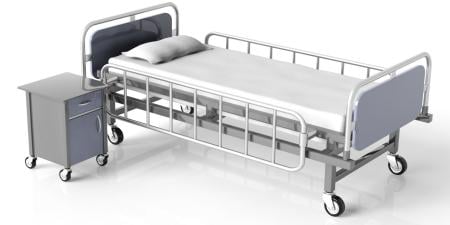Case
Dr. Michaels was an experienced ER attending physician in a major level 1 trauma center working the night shift. It had been a relatively slow shift so far, so he had spent a lot of time teaching his new intern, Jay. Just after 11 p.m., Jay came to present a 53-year-old patient, Mr. Brower, who was experiencing sudden-onset back pain with numbness and tingling down his leg after having lifted a heavy box. Jay had conducted a thorough history and physical, and Dr. Michaels agreed with his assessment that Mr. Brower had a herniated disc in his lumbosacral spine.
Dr. Michaels asked Mr. Brower to repeat the events surrounding the onset of his back pain, reviewed Mr. Brower’s physical findings, and gave Jay the signal to explain the diagnosis. After explaining the anatomy of the spine and how the herniated disk could cause Mr. Brower’s leg symptoms, Jay recommended 2 days of limited activity and treatment with a nonsteroidal anti-inflammatory drug followed by a return to normal activities. He then added that if Mr. Brower’s symptoms did not improve, he could come back for further testing, including an MRI to confirm the diagnosis. Confused, Mr. Brower asked why they did not want to perform an MRI now.
Dr. Michaels stepped in to explain that, given Mr. Brower’s history and physical, there was little doubt that the cause of his discomfort was a herniated disc. “We are confident of the diagnosis, Mr. Brower, having often seen the symptoms you report following an event like you describe—lifting the heavy box. We always recommend conservative management first. If your symptoms improve, which they most likely will, there’s no reason to be concerned. Further imaging and testing is really only necessary when our ‘tried and true’ methods of treatment don’t work. We’ll follow you closely to see how you do.”
“But Doc,” Mr. Brower protested, “why not just do the MRI now? I’m here already and I want to be sure it’s just this disc thing you’re talking about. My insurance will pay for it, so I don’t understand what the big deal is. Is this a cost-cutting thing? I don’t want my health to suffer just to help your hospital’s bottom line!”
Commentary
It is difficult to find oneself in disagreement with the wishes or desires of a patient. We live in a society that values patient autonomy highly. Patients are often in role of consumers and have expectations about the service they are receiving. Yet physicians must also keep in mind the overriding context of care while working to benefit their patients’ health.
Health care resources are not without limit, which the national debate is making increasingly clear. And allowing unlimited access to certain resources sometimes renders them unavailable to other patients. One way to frame the tension in this scenario is to look at it as a conflict between two basic tenets: autonomy and distributive justice. How can we best balance our stewardship of limited resources with patients’ desire to direct their own care?
With regard to a resource such as MRI access, which is limited because of its cost, the wishes of an individual patient may be overridden by the ethical principle of distributive justice: making scarce resources available to those who need them. A just distribution of resources allocates preferentially to those who need rather than want the MRI. Concern for justice should prompt the clinician—and patient—to assess whether the premature use, as defined by medical indication, of a scarce resource is appropriate given that it may not be available when it is needed for another patient. In a just health care system, does the patient’s right to make autonomous decisions about health care entitle him or her to make requests that limit resource availability for other patients?
Another way to frame the tension is to see it as a conflict between respect for patient autonomy and physicians’ clinical judgment. When a patient in a tertiary or quarternary care center requests a test or therapy that we would not recommend or that is not medically indicated, what obligation do we have to acquiesce? The physician in this case must balance respect for the patient’s autonomy with his or her own judgment to uphold both the principle of nonmaleficence—exposing the patient only to the risks of therapies that are indicated and necessary—and distributive justice.
Do we treat patients like customers in a department store? Or can we—must we?—temper their autonomy with the paternalistic goal of doing what is in the patient’s best interest while also distributing resources to those who need them most? Unlike a department store, which encourages consumers to purchase whatever they want and can afford in accordance with the business’s goal of selling as much inventory as possible, the health care setting has limited resources and the interventions available are not without risk to the patient or patient pool. Physicians avoid harm where possible, yet we would posit that a patient’s right to an autonomous decision does not compel physicians to perform tests or treatments they believe to be outside the realm of indicated practice.
Patients seek doctors not only for the access they provide to therapeutic and diagnostic interventions; they seek the counsel of physicians because of their years of study and insight. Acquiescing in the moment could compromise the care of the next patient without providing clear benefit (and, sometimes causing harm) to the present patient. Thus, a physician whose patient requests a nonindicated test is not ethically bound to fulfill it. While this view might be unpopular with those patients who view health care as a consumer good, it is not unethical to withhold nonindicatedtreatment in the name of distributive justice.
In response to the patient’s question whether this is a cost-cutting measure to save the hospital money, all communication should be honest and start with reassurance that patient need, as opposed to finances or convenience, drives clinical-decision-making. Furthermore, the physician should explain that a 2-day delay is not withholding care, but giving the patient time to recover so that he will only be exposed to the risks of testing if it is absolutely necessary. Not only is no test benign, but false positives have risen as nonindicated testing increases, and an MRI might expose him to further unnecessary risk if a false positive prompted unnecessary intervention. If he waits the 2 days, these risks will be minimized—and the cost of testing will only be incurred if needed.
In our current context of care, as we strive to improve health outcomes while containing costs through conscientious stewardship of our health care resources, it is essential to identify the limits of what is possible ethically. From this discussion, we contend that whether one views health care as a market commodity or public good, there should be ethical limits on requests for interventions, tests, and therapies that are not medically indicated. Physicians are ethically justified by the principle of distributive justice to decline this request if and when the resource is scarce, and deny a service that is not medically indicated.



